3. Reproduction and Inheritance
1/133
Earn XP
Description and Tags
Name | Mastery | Learn | Test | Matching | Spaced |
|---|
No study sessions yet.
134 Terms
Sexual reproduction:
The process involving the fusion of the nuclei of two gametes to form a zygote and the production of offspring that are genetically different from each other.
Gamete:
Reproductive sex cell that fuses with another gamete during fertilisation.
Zygote:
The diploid cell from which an organism develops, and is formed from the fusion of gametes.
What are the gametes in animals?
Sperm and ovum
What are the gametes in plants?
Pollen nucleus and ovum
Why are gametes different from normal cells?
Gametes contain half the number of chromosomes found in other body cells, they contain a haploid nucleus.
Normal body cells contain … chromosomes
46
Gametes contain … chromosomes
23
How many chromosomes does a zygote have?
46 and it has a diploid nucleus
Advantages and disadvantages of sexual reproduction:
+ve:
increases genetic variation
the species can adapt to new environments due to variation, giving them a survival advantage
Disease is likely to affect population
-ve:
take time and energy to find mates
Difficult if isolated members of the species to reproduce
Asexual reproduction:
The process resulting in genetically identical offspring being produced from one parent. This does not involve the fertilisation or gametes.
Why are offsprings from asexual reproduction genetically identical to the parent and to each other?
One one parent is involved to reproduction therefore there is not mixing of genetic information. Due to this, the offspring is genetically identical.
Binary fission:
When Bacteria produce exact genetic copies of themselves in a type of asexual reproduction
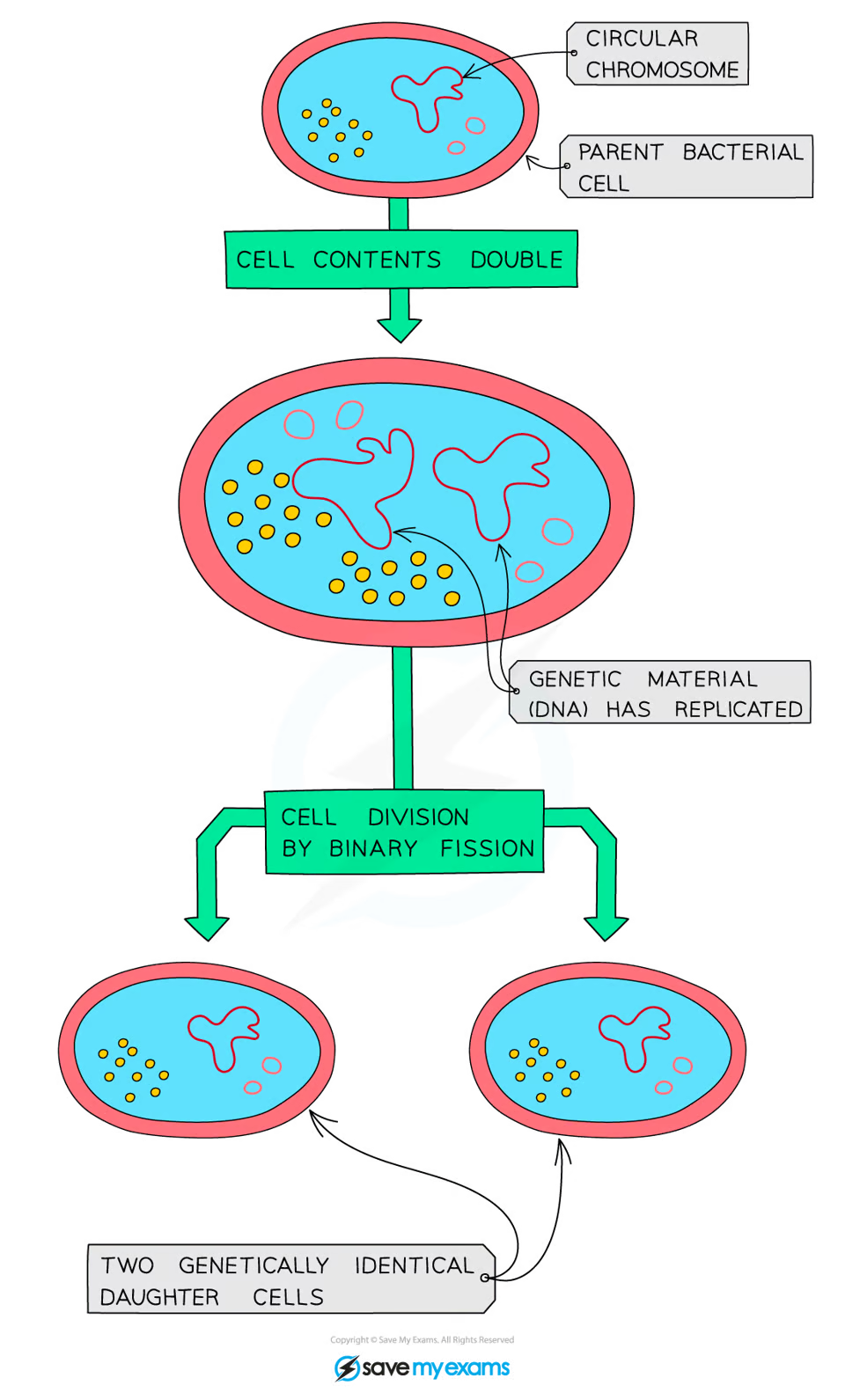
What are the advatages and disadvantages of asexual reproduction?
+ves:
population can be increased rapidly
can exploit suitable environments quickly
quick and energy efficient
-ves:
limited genetic variation in the population- offspring is genetically identical
population is vulnerable to changes in conditions- suited to only one habitat
diseases likely to affect whole population
What is the difference between asexual and sexual reproduction?
Feature | Asexual Reproduction | Sexual Reproduction |
Number of parent cells | One | Two |
Type of cell division | Mitosis | Meiosis |
Level of genetic similarity | Genetically identical | Genetically unique |
Sources of genetic variation in offspring | Only one source: mutation | Three sources:
|
Number of offspring produced | Usually relatively large numbers | Usually relatively limited numbers |
Time taken to produce offspring | Usually relatively fast | Usually relatively slowly |
Describe fertilisation Humans:
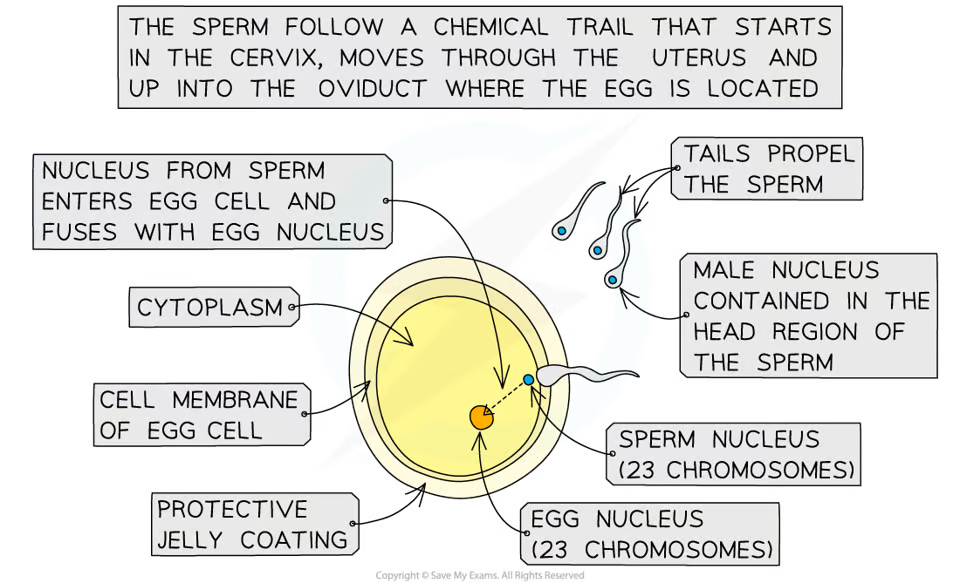
Fertlisation in Plants
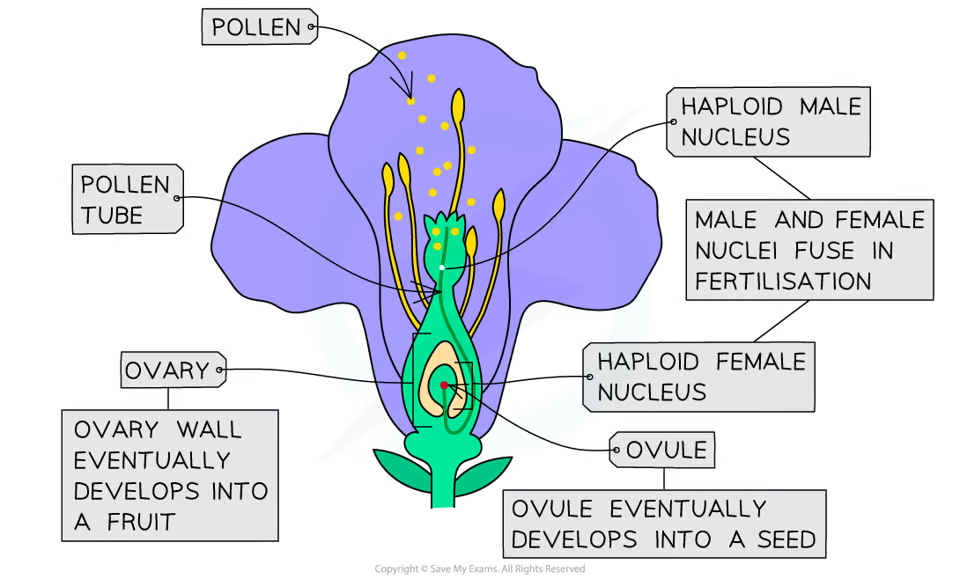
… are the reproductive organs of plants. Plants produce … whoch contains a nucleus inside that is the male gamete. Pollen is … of locomotion.
Flowers are the reproductive organs of plants. Plants produce pollen, which contains a nucleus inside that is the male gamete. pollen is not capable of locomotion
Pollination:
The transfer of pollen from the anther to the stigma
What are the two main types of pollination?
Wind pollination and Insect pollination
What is the name of the male and female parts of a flower and what do they include?
Carpel/pistol (female) : stigma, style, ovary
Stamen: anther, filament

Sepal:
protects unopened flower
Petals:
brightly coloured in insect- pollination flowers to attract insects
Anther:
produces and releases the male sex cell (pollen grain)
Stigma:
top of the female part of the flower which collects pollen frain
Ovary:
produces the female sex ovum
Ovule:
prodces the femail sex cell (ovum)
Ovule:
contains the female sex cells
Filament:
a structure that hold the anther
Features of an insect pollinated plant:
Petals: large and bright to attract insects
Scent and nectar: present so insect pushes past stamen (in nectry)
Number of pollen grains: moderate cuz high efficiency
Pollen grains: larger, sticky to be carried away
Anthers: inside flower, stiff and firmly attached to brush against insects
Syigma: inside flower, sticky so pollen grains stick to it
Describe how insect pollination takes place?
Insects will visit flowers to collect nectar. As the insect enters flower, it brushes against the anthers which deposit sticky pollen onto the insects body. When insects visit another flower for nectar, it brishes against the stigma of this second lower and the pollen is deposited.
Features of a wind pollinated plant:
Petals: small and dull
scent and nectar: absent
Number of pollen grains: large amounts
Pollen grains: smooth, small, light
Anthers: outsidethe flower
Stigma: outside the flower
Cross pollination:
Pollination on a different plant of the same species. Increases genetic variation therfore survial. But takes time.
Self pollination:
Pollination on the same plant or flower. Very fast but reduced genetic variation.
Describe the process of fertlisation in plants:
When the pollen grain land of the sticky anther, the sugary syrup causes the grain to grow a pollen tube down the style to the ovary. The pollen nucleus moves down the tube to the ovule and fuses with the ovum. They form a zygote and it starts dividing to develop into an embryo plant.
Describe the formation of a seed and fruit:
After fertlisation. the ovule develops into the seed and the wall of the ovule develops into the seed coat known as testa. The ovary walls develop into a fruit and then the seed is disperesed.
What are theconditions required for germination?
Germination requires the presence of moisture, oxyygen and warm temperature.
Germination:
the start of growth in the seed
When the seed germinates, the embryo begins to grow into a young…
seedling
Name the stuctute that surrounds the plant embryo:
Cotyledons
How are cotyledons adapted to support growth of the seedling?
they contain food reserves that supply the seedling with energy for growth when it germinates
Describe the process of germination:
the seed contains the zygote which divides into cells that then develop into the embryo plant
the embryo is supplied wih energy from the cotyledon until it had leaves for photosynthesis
After the intake of water, the testa (seed coat) splits.
this triggers the production of plumule( first emerging shoot) and radicle( first emerging root)
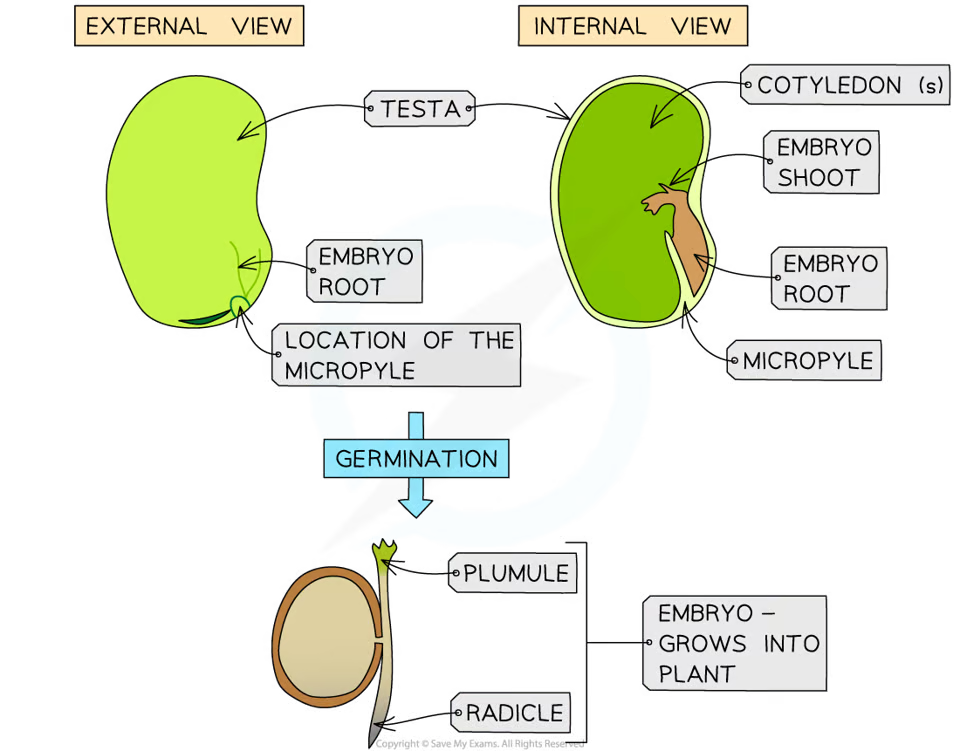
Describe an example of natural asexual reproduction in plants:
Runners:
Some plants grow side branches, known as runners, that have small plantlets at their ends
Runners are horizontal stems that grow sideways out of the parent plant
Once they touch the soil, these plantlets will grow roots and the new plantlets will grow and become independent from the parent plant
Describe an example of artificial reproduction in plants:
Cuttings:
A section of the parent plant with a new bud is cut off and replanted. The cutting is often dipped in rooting powder to trigger hormones for new root growth.
Organs in the male reproductive system:
Prostate gland, Sperm duct, Urethera, Testis, Scrotum, Penis
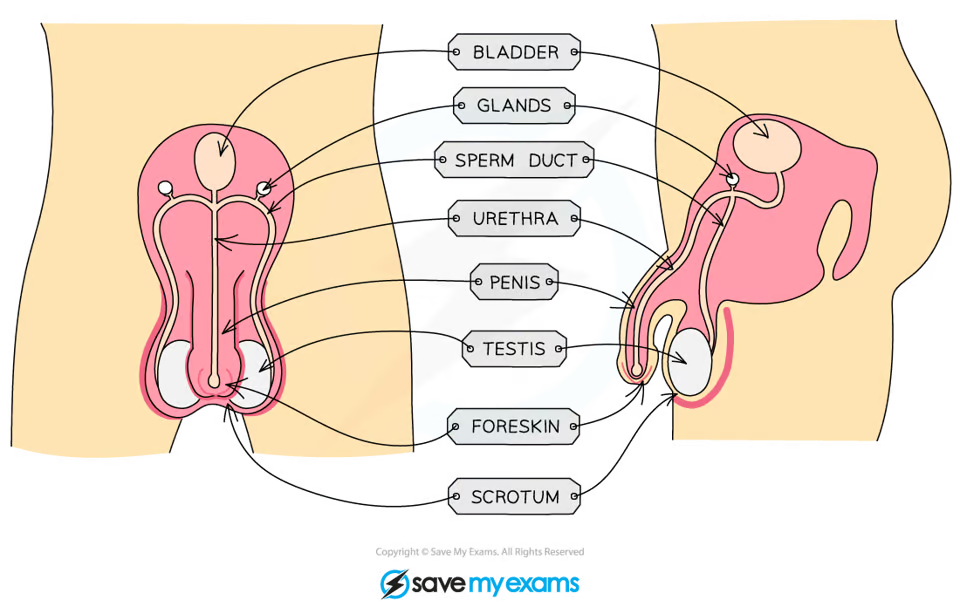
Prostate gland:
produces fluid called smen that provides sperm cells with nutrients
Sperm duct:
sperm passes through the sperm duct to be mixed with fluids produced by the glands before being passed into the urethra for ejaculation
Urethra:
tube running down the centre of the penis that can carry out urine or semen, a ring of muscle in the urethra prevents the urine and semen from mixing
Testis:
contained in a bag o skin(scrotum) and produces sperm (male gamete) and testostrone (hormone)
Scrotum:
sac supporting the testes oustide the body to ensure sperm are kept at a lower temp
Penis:
passes urine out of the body from the bladder and allows semen to pass into the vagina of a woman during sexual intercourse
organs in the female reproductive system:
oviduct, ovary, uterus, cervix, vagina
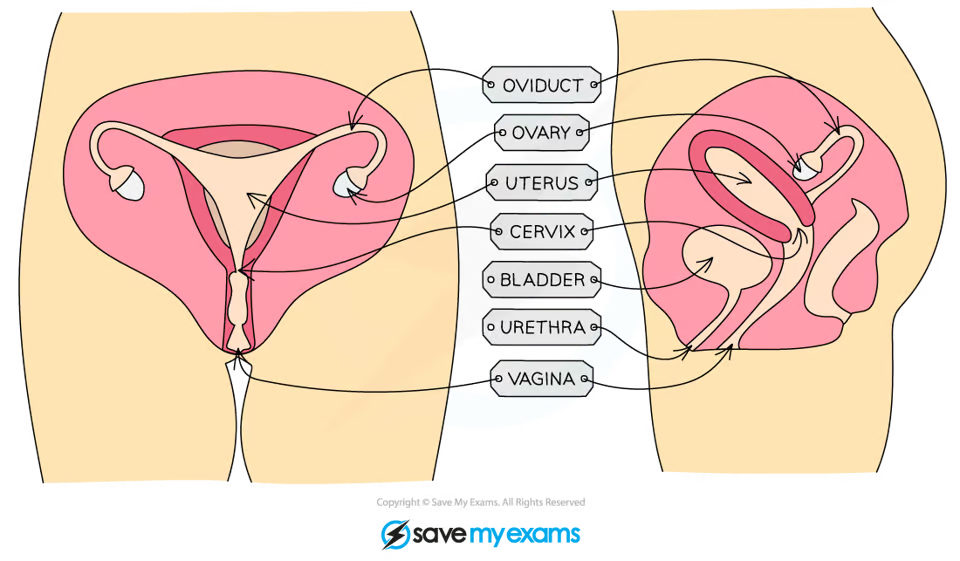
oviduct:
connects the ovary to the uterus and is lined with cilliated cells to push the released ovum down it. site of fertlisation
Ovary:
contains ova (female gametes) which will mature and develop when hormones are released
uterus:
muscular bag with a soft lining where the fertilised egg(zygote) will be implanted to develop into a foetus
cervix:
ring of muscle at the lower end of the uterus to keep the developng foetus in place during pregnancy
Vagina:
muscular tube that leads to the inside of the woman’s body, where the male’s penis will enter during sex + where sperm is deposited
What are the adaptations of a sperm cell:
has a flagellum: enables it to swim to the egg
contains enzymes in the acrosome: to digest through the jelly coat+ cell memb of an egg cell
contains alot of mitochondria: to provide energy from respiration for locomotion (flagellum)
What are the adaptations of an ovum:
cytoplasm containing a store of energy: providesenergy for the dividing zygote after fertlisation
jelly like coating that changes after fertlisaion: forms an impenetratable barrier afetr fertilisation to prevent other sperm nuclei entering the egg cell
How does fertlisation take place in humans?
During sexual intercourse, semen is ejaculated into the vagina of a female. The sperm in the semen follow a chemical trail and swim to the uterus. They travel into the oviducts where they meet the ovum. The head of the sperm releases enzymes that digest the outer layer of the ovum. The fusion takes place and the egg cell releases a thick layer of material that prevents any more sperm cells from entering.
How long does the menstrual cycle last?
28 days
Ovulation:
the release of an egg occurs about halfway through the cycle
Menstruation:
The shedding of the uterus lining when the egg is not fertlised ( lasts 5-7 days)
Describe the change in hormones during the menstrual cycle:
The pituitary gland produces FSH which stimulates the development of a follicle in the ovary. An egg develops inside the follicle and the follicle produces the hormone oestrogen
Oestrogen causes growth and repair of the lining of the uterus wall and inhibits production of FSH. When oestrogen rises to a high enough level it stimulates the release of LH from the pituitary gland which causes ovulation (usually around day 14 of the cycle)
The follicle becomes the corpus luteum and starts producing progesterone. Progesterone maintains the uterus lining (the thickness of the uterus wall). If the ovum is not fertilised, the corpus luteum breaks down and progesterone levels drop. This causes menstruation, where the uterus lining breaks down and is removed through the vagina - commonly known as having a period
If pregnancy does occur the corpus luteum continues to produce progesterone, preventing the uterus lining from breaking down and aborting the pregnancy
It does this until the placenta has developed, at which point it starts secreting progesterone and continues to do so throughout the pregnancy
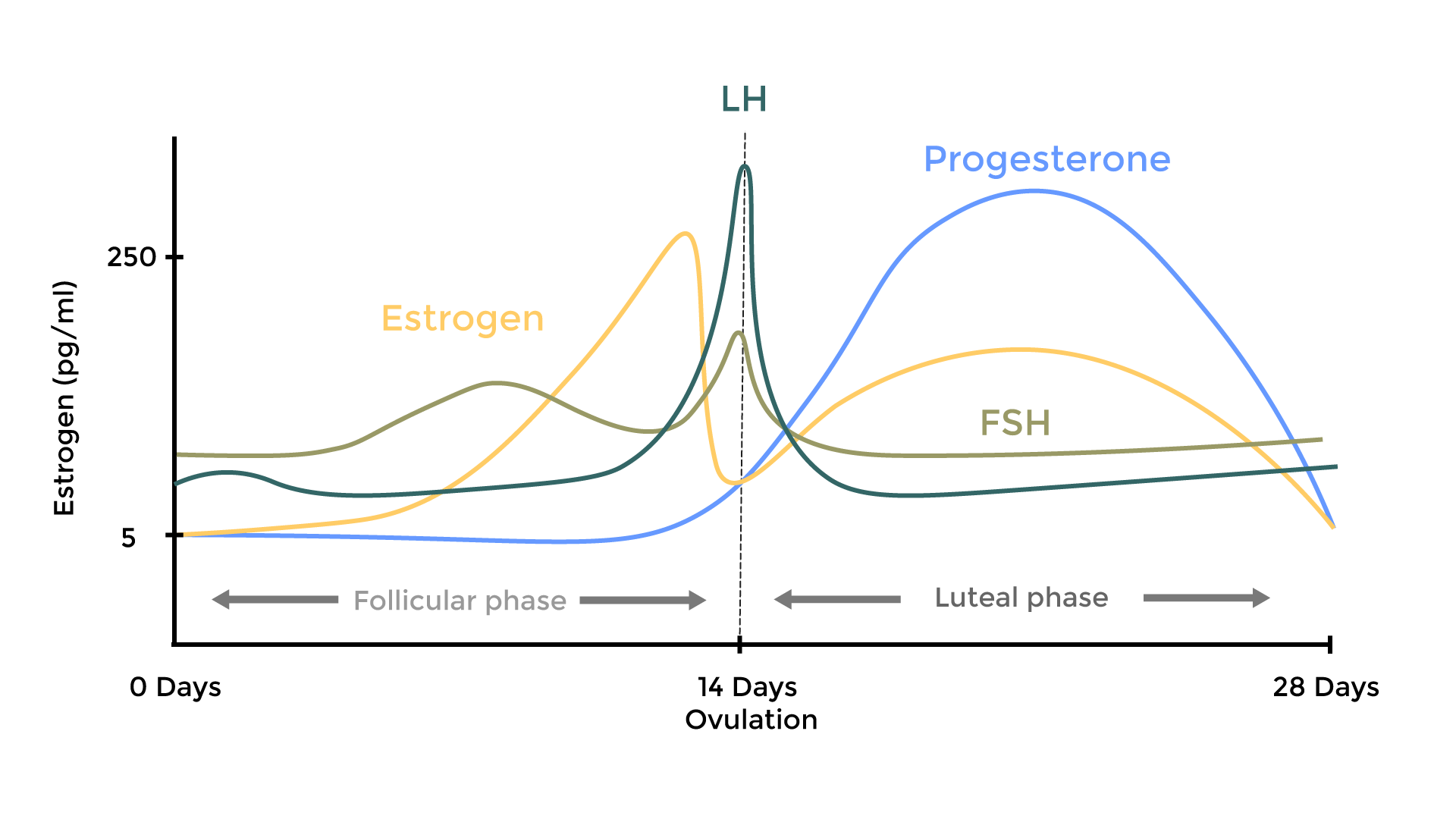
What is the function of the placenta?
The placenta is an organ, where the mother’s and baby’s blood are in proximity for the exchange of glucose, amino acids, fatty acids, water, oxygen, mineral ions vitamins, antibodies and waste products (co2 + Urea). The foetus’s blood connect to the placenta by the umbilical cord.
How is the placenta adapted for its function?
The placenta is adapted for this diffusion by having a large surface area(fetal villi) and a thin wall for efficient diffusion
The placenta acts as a barrier to prevent toxins and pathogens getting into the foetus’s blood
Describe the pocess of implantation:
After fertlisation, the zygote travels towards the uterus while dividing and forming an embryo (takes 3 days).
the embryo embeds itself in the thick lining of the uterus (implantation) and grows
a placenta is formed where the embryo is attached
the embryo is surrounded by amnotic fluid
What is Amniotic fluid:
a fluid made from the mother’s plasma, held in the amniotic membrane/ sac which protects the embryo by cushioning it from bumps to the mother’s abdomen.
Gestation period:
the growth of the embryo in the uterus ( 9 months)
What hormones are responsible for secondary sexual characteristics?
Females: Oestrogen
Males: Testosterone
Female secondary sexual characteristics:
breasts develop
body hair grows
menstrual cycle begins
hips get wider
Male secondary sexual characteristics:
growth of penis and testes
growth of facial and body hair
muscles develop
voice breaks
testes start to produce sperm
Genome:
the entire set of genetic material for an organism
Genomes are made up of…
Genes
Genes:
a small section of DNA that codes for a particular sequence of amino acids
Alleles:
Different versions of a gene. Having 2 alleles of the same type is called homozygous. Having 2 alleles that are different to one another is called heterozygous.
Examples of proteins:
structural proteins ( collagen)
Enzymes (Amylase)
Hormones (LH)
Functions of genes:
Genes control our characteristics as they code for proteins that play important roles in what our cells do
the DNA double helix super coils to form…
Chromosomes
Chromosomes are found in the…
nucleus
Sex chromosome in females:
xx
Sex chromosome in males:
xy
What is DNA?
(Deoxyribonucklec acid) is th genetic material found in the nucleus of a cell. It is a polymer made up of two strands coiled around to make a double helix. The strands are formed from a sugar phosphate backbone with bases joined together by complementary base pairings.
What are the 4 bases in DNA?
Adenine
Thymine
Guanine
Cytosine
Adenine pairs with …
thymine
Guanine pairs with…
cytosine
How many copies of each chromosome do we have?
2
How many copied of each gene do we have?
2
How many alleles do we have for 1 gene?
2
Phenotype:
observale characteristics of an organism
Genotype:
The combination of alleles that control each characteristic (BB, Bb, bb)
Dominant alleles:
A dominant allele only needs to be inherited from one parent in order for the characteristic to show up in the phenotype
Recessive alleles:
A recessive allele needs to be inherited from both parents in order for the characteristic to show up in the phenotype.
Polygenic inheritance:
when characteristics are controlled by more than one gene ( such as eye colour)
True or false: Only a father can pass on a y chromosome:
True
How is the sex of an off spring determined? (Human)
All egg cells and sperm will have an x chromosome
only half of the sperm will have a y chromosome
Mitosis:
nuclear division giving rise to genetically identical cells (daploid cells)
What is mitosis used for?
growth, repair of damaged tissue, replacement of cells and asexual reproduction
Describe the process of mitosis:
Each chromosome in the nucleus is duplicated.
The nuclear memebrane breaks down
chromosomes line up along the centre of the cell
once the chromatids have been sperated, the cell begins to divide(cytokinesis)
two genetically identical daughter cells are produced
All cells in the body ( except gametes) are produced by … of a zygote.
Mitosis